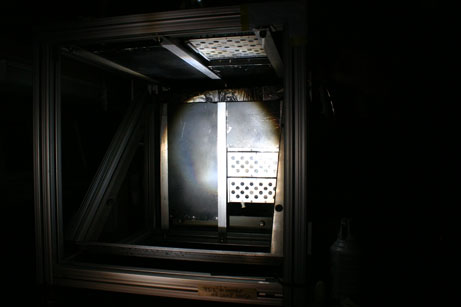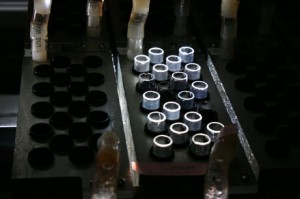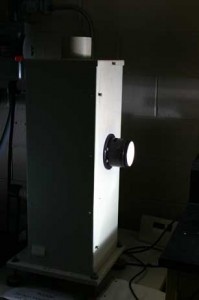For many SERC scientists, field research comes to a halt in the winter. Some manage to head off to the tropics to investigate invasive species or mangroves, but not photobiologist Pat Neale. Neale and his assistants are spending a good part of their time these days in his lab with the Beast.
The Beast does not bite, but if you look at it the wrong way it will hurt you. In fact it can char your corneas if you’re not careful. That’s because it reflects and filters ultraviolet light. UV rays are invisible to the naked eye, but are high in energy and potentially damaging to animals and plants. As a photobiologist Neale studies how UV rays affect aquatic environments and the organisms that live in them.
The Beast’s official name is the photoinhibitron. Neale and associates developed the first one 18 years ago; the current version has been in use six years. The photoinhibitron allows him to study how different segments of the ultraviolet spectrum affect photosynthetic rates in phytoplankton. Phytoplankton form the base of the ocean’s food web and include diatoms and dinoflagellates. These organisms are called primary producers because they make their own food through photosynthesis – all they need is a little sunlight. Phytoplankton also generate much of the Earth’s oxygen. Their fate affects the health of the entire planet.

The photoinhibitron's mirror reflects the light filters and the cuvettes that sit on top of the device.
Neale has conducted many experiments to-date with the photoinhibitron. Presently he’s working on what he describes as “a big ‘what if?’ project.” With funding from NASA, he’s joined forces with two astrophysicists Brian Thomas at Washburn University and Adrian Melott at University of Kansas.
The three investigators will explore what might happen to life on Earth if a gamma-ray burst hits the planet. These are the powerful beams of radiation that certain stars emit when they die. Neale’s role in the project is to simulate what is expected to be the main effect of gamma-ray burst on Earth: wiping out much of the protective ozone layer. Enter: the Beast.

The phytoplankton in these quartz cuvettes are getting some rays from the xenon light. The cuvettes are in a temperature-controlled environment so they won't get too hot.
The 2.5kW xenon light that shines on the photoinhibitron doesn’t emit gamma-rays, but its UV emission is similar to the sun. The light bounces off a mirror, through filters and into quartz cuvettes that contain phytoplankton. The filters allow all visible light to reach the cuvettes, but they let Neale control what part of the UV spectrum hits a particular phytoplankton sample. This enables him to measure how much damage occurs to photosynthesis.

The 2.5kW xenon light that shines on the photoinhibitron emits UV rays that are similar to those released by the sun.
UV rays break down into three categories: A, B and C. UV-A and UV-B are what strong sunscreens try to protect against. And of the three, UV-C rays have the shortest wavelength and are the most toxic to living organisms. Fortunately our atmosphere filters out all UV-C light and the stratospheric ozone layer removes much of the UV-B. However, if a gamma-ray burst hits the Earth, it could damage the ozone layer and allow many more UV-B rays to shine down on us, phytoplankton and everything else on the planet.
In this experiment, Neale’s group carefully controls the UV-B spectrum to correspond to how much would hit the Earth after different types of gamma-ray bursts. With these results, he will work with the astrophysicists to put together a computer model for how much oceanic primary production would be lost if Earth received a gamma-ray “hit”.
Neale expects to spend quality time with the Beast well into the summer, using several of the most common forms of oceanic phytoplankton. After that, they will start putting together computer models with the work continuing into next year.
You can find out more about Pat Neale’s work on the SERC Web site.



Interesting research. Is there a way I can keep track of and find out the outcome of this research ?
Thanks !
Hi There, Thanks for your question. The results won’t likely be published for a year or two. That’s a long time to wait, but please check back here for updates. We do hope to post a video of Pat Neale and the Beast in a couple months. Best, Tina
This is my 1st comment here so I just wanted to give a quick shout out and tell you I genuinely enjoy reading through your articles.